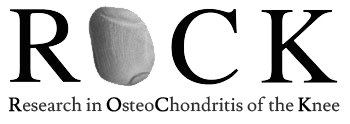Learning about OCD can not only put your mind at ease about you or your child’s treatment, but it can also help you make an informed decision. We have many case loads that reflect common scenarios patients face. We also have provided a list of resources to find more information.
OCD of the Knee
Theodore Ganley MD, Kevin Shea MD
When OCD affects the knee, the most common location is within the lateral aspect of the medial femoral condyle. Juvenile OCD lesions have a better healing prognosis than adults. Generally, OCD seems to affect males more commonly than females (between 2:1 and 3:1). However, as females and younger children participate in sports there has been an increased prevalence among girls and a younger mean age of OCD onset.
Etiology/ Pathoanatomy
The causes of OCD are unknown, however repetitive trauma, inflammation, accessory centers of ossification, ischemia, and genetic factors show causative correlation. ). Some familial tendencies exist, but non-familial OCD is most prevalent. Repetitive trauma caused by year round sports, early sports specialization, multiple sports in a singe leason or multiple teams in a single sport and increased training intensity are some of the causative factor associated with OCD. Chronic repetitive microtrauma has been suggested to lead to a stress reaction within the subchondral bone and in more severe cases subchondral bone necrosis where fragment dissection and separation may ensue.
Evaluation
Patients with OCD of knee initially have nonspecific complaints, with anterior knee pain and variable amounts of intermittent swelling. With progression of the disease, patients may complain of more persistent swelling or effusion, catching, locking, and/or giving way. Unfortunately, pain and swelling are not good indicators of dissection. Physical findings may include a positive Wilson test, which reproduces the pain by internally rotating the tibia during extension of the knee between 90 and 30 degrees, then relieving the pain with tibial external rotation. The premise for this test is that the tibial eminence impinges on the OCD lesion in internal rotation and extension; whereas, external rotation moves the eminence away from the lesion.
Standard weight-bearing radiographs of both knees are helpful for initially characterizing the lesion type and status of the growth plate. The lateral view helps identify anterior-posterior lesion location and normal, benign accessory ossification centers in the skeletally immature knee. An axial view is helpful if a lesion of the patella or trochlea is suspected, and a “notch view” in 30 to 50 degrees of knee flexion may help identify the lesions of the posterior femoral condyle.
Studies have been performed to attempt to identify specific MRI findings that link the ability of OCD lesions to heal following non-operative treatment.
Non-Operative Treatment
The goal of non-operative intervention is to promote healing in the subchondral bone and prevent chondral collapse, subsequent fracture, and crater formation. The treatment depends on skeletal maturity of the patient, as well as the size, stability, and location of the lesion as the more skeletally mature a patient, the worse the prognosis. Non-surgical treatment is the treatment of choice for small stable lesions in skeletally immature patients with wide open physes and no signs of instability on MRI. Nonsurgical management focuses on significant activity modification by limiting high impact activities. Short-term immobilization and protected weight bearing may be helpful. Alternatively, bracing and range-of-motion knee exercises may be beneficial. Typically a period of three to nine months of non-operative treatment is initiated. Surgical treatment to promote healing is suggested when non-surgical methods fail and for skeletally mature patients with large lesions.
Operative Treatment
Surgical management begins with arthroscopy . Operative treatment should be considered for patients with unstable or detached lesions, failed non-operative treatment, and for patients approaching skeletal maturity. The goals of operative treatment are to promote healing of subchondral bone, to maintain joint congruity, to fix rigidly unstable fragments, and to replace osteochondral defects with cells that can replace and grow cartilage. (53) Optimal surgical treatment provides a stable construct of subchondral bone, calcified tidemark, and repair cartilage with viability and biomechanical properties equivalent to or similar to native hyaline cartilage.
Surgical treatment for stable lesions with intact articular cartilage involves drilling the subchondral bone with the intention of stimulating vascular ingrowth and subchondral bone healing. If the lesion is unstable and hinged, fixation is indicated. For patients with a hinged lesion without subchondral support, bone grafting is indicated to restore articular congruency. The goal is to fix the osseous portion of the fragment to allow healing and stabilization of the overlying articular surface. Arthroscopic or open reduction and internal fixation can be performed with hardware using Kirschner wires, cannulated screws, or Herbert screws. Associated complications include implant migration, adjacent cartilage damage, and hardware fracture. Osteochondral plugs have recently been presented as a biologic alternative to the use of hardware. The plugs provide bone graft as well as fixation of the lesion (26,34)
If fixation is not possible, there are several salvage techniques for full-thickness defects, including marrow stimulation techniques such as microfracture as well as autologous chondrocyte implantation, and osteochondral autograft transplantation. However, these techniques have limited clinical outcome data in adolescents.

